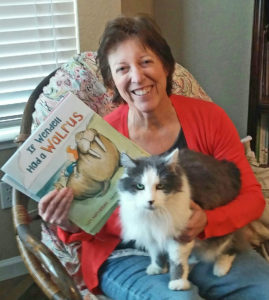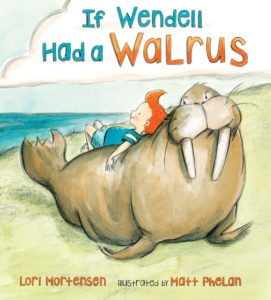This month’s Author Interview is with Lori Mortensen, an award-winning children’s book author of more than 70 books and over 350 stories and articles. Her recent picture book releases include If Wendell Had a Walrus, Chicken Lily, Mousequerade Ball illustrated by New York Times bestselling illustrator Betsy Lewin, and Cowpoke Clyde Rides the Range, a sequel to Cowpoke Clyde & Dirty Dawg, one of Amazon’s best picture books of 2013.
 When she’s not letting her cat in, or out, or in, she’s tapping away at her computer, conjuring, coaxing, and prodding her latest stories to life. Sometimes takes a break and answers marvelous questions posed by Ryan G. Van Cleave at Only Picture Books.
When she’s not letting her cat in, or out, or in, she’s tapping away at her computer, conjuring, coaxing, and prodding her latest stories to life. Sometimes takes a break and answers marvelous questions posed by Ryan G. Van Cleave at Only Picture Books.
For more information about her books, critique service, events, and upcoming releases, visit her website at www.lorimortensen.com.
Blog: http://lorimortensen.blogspot.com
Twitter: https://twitter.com/lorimortensen
Facebook: https://www.facebook.com/lori.mortensen.77
Goodreads: https://www.goodreads.com/author/show/90109.Lori_Mortensen
RVC: At what point did you realize that you were a writer? What were the warning signs?
LM: Interestingly, I didn’t begin writing until I was a stay-at-home mother of three. Up until then, I was an avid reader, but writing never occurred to me. I’d never met a writer, and the whole thing seemed completely out of the realm of possibilities. However, when I had my own children, I was reintroduced to children’s literature and began to wonder what I could write.
Taking a gigantic step, I signed up for a writing course through the Institute of Children’s Literature. Although I was a complete beginner, I soaked up each lesson like a sponge and each step was a thrilling challenge. When I sold my final assignment to a children’s magazine, I was hooked. If they wanted this story, maybe they’d want another. And if they bought something, maybe another publisher would too. I’ve been writing ever since.
It’s been my privilege to be a writing instructor for the Institute of Children’s Literature for the past 12 years which continues to be a rewarding, full-circle experience.
RVC: How does your teaching at the Institute inform your own writing?
LM: The particular course I teach is writing for children’s magazines. After reading and critiquing hundreds of manuscripts, it’s easy to see the common mistakes nearly all new writers make. When I began writing many years ago, I made them too. But over time, challenge by challenge, writers improve as they put in the time to understand and hone their craft.
Most students are surprised at the work and persistence it takes to succeed. Some decide writing is not for them. However, when students catch the vision and are willing to put in the work, success follows. Teaching is a regular reminder that writers can improve, and whatever measure of success they achieve is in direct proportion to the effort they’re willing to put into it. It’s a truism for nearly anything in life.
RVC: What are a few of those common mistakes that nearly all new writers make?
LM: The most common mistakes have to do with point of view and conflict. Many new writers create a cast of characters and then try to tell everyone’s story all at once. By jumping from one point of view to the next, they end up not telling anyone’s story. If there was a main character, they were quickly lost in the shuffle.
Lack of conflict is another common mistake. Many new writers don’t realize that there needs to be a story problem for the main character to face and resolve. Without conflict, there is no story or reason to keep reading. Who resolves the story problem is just as critical. Many times, new authors just can’t help putting parents in charge. The parents tell the main character what to do and teach them a lesson that’s usually about not lying, stealing, or cheating. It’s a challenge for new authors to see things from a child’s perspective instead of the wise, responsible adult’s.
RVC: Your Twitter bio claims that you’re the not-so-proud owner of a “misbehaving muse.” Tell me more.
LM: If I could tame that muse, I certainly would. As it is, sometimes ideas land at my feet and blossom into wonderful, exciting projects, and other times it’s a wrestling match to see who will come out on top. While many writers lose count of all the ideas popping into their head, for me it’s more like a Sherlock Holmes affair. Instead of fending off a deluge of ideas, I have to pluck them out of my world like shiny pennies waiting to be found. In either case, it’s an exhilarating and rewarding process to see an idea come together in its finished form.
Now if my muse would get on the ball, I’d get bushels of projects done!
RVC: What does your writing process look like, and what role does revision play in it?
LM: My writing process begins with an idea. Where that idea comes from is the challenge. Sometimes an idea lands at my feet. Other times, I show up at my computer with nothing in mind and know I need to get started on something. I often start the process by immersing myself in the collection of picture books in my bookcase. Sometimes the rhythm of the language sparks an idea. Other times, it’s an illustration or style that gets me thinking. Then, I start writing and see where it takes me. Many times, I don’t know where it’s going when I begin, but as I progress, new ideas come to mind and the story begins to take shape.
Getting through the first draft is the biggest hurtle because it would be so easy to toss it in the bin at this point. What a horrible, ill-conceived mess! But luckily, I’ve learned to trust the revision process. How many times do I revise? Numbers aren’t important, but quality is. When the manuscript is as good as I can make it, I share it with my trusted critique partners knowing they’ll see things I missed. Once the feedback is in, I return to the revision process. I may not agree with everything they’ve said, but their feedback is invaluable. They not only celebrate what’s wonderful about the manuscript, they help me see where it falls short and how it can be improved.
RVC: Why picture books?
LM: Although I’m an avid reader of adult literature—cozy mysteries, biographies, and a variety of nonfiction, I love to read and write picture books. To me, they’re like mini masterpieces—clever, humorous, smart, informative, whimsical, and unforgettable—all packed within 32 pages. I love the awesome mashup of the words and art and the challenge of writing what I would love to read.
RVC: The first book of yours that I ever ran across was Cindy Moo, where a cow hears the age-old nursery rhyme and decides to prove that cows CAN jump over the moon. How do you know when rhyme is right for a book—like it is for Cindy Moo—or when it’s going to get in the way of the story?
LM: In the case of Cindy Moo, it was clear from the beginning that I would tell this story in rhyme because it was based on the rhyming nursery rhyme, Hey Diddle Diddle. I wrote the Cowpoke Clyde and Dirty Dawg series in rhyme because it seemed like the perfect way to capture Cowpoke Clyde’s rambunctious efforts to catch ol’ Dirty Dawg. Rhyme has a rhythm so I used it to magnify the energy and pace of the chase. As you noted, however, rhyme isn’t suited for everything.
 For me, the key is finding the voice of the story. Some ideas lend themselves to rhyme and others don’t. For example, when I began writing If Wendell Had a Walrus, this opening line came to mind: “One day Wendell was minding his own business when a walrus floated by. Of course, it wasn’t a real walrus. Just a cloud one. But when Wendell saw it, he started thinking about real ones all the same.” In this instance, writing it in prose captured the thoughtful nature of the moment where the character was simply looking up at the clouds and imagining.
For me, the key is finding the voice of the story. Some ideas lend themselves to rhyme and others don’t. For example, when I began writing If Wendell Had a Walrus, this opening line came to mind: “One day Wendell was minding his own business when a walrus floated by. Of course, it wasn’t a real walrus. Just a cloud one. But when Wendell saw it, he started thinking about real ones all the same.” In this instance, writing it in prose captured the thoughtful nature of the moment where the character was simply looking up at the clouds and imagining.
RVC: Music or silence when writing?
LM: Silence. I’ve always thought it would be great to write with music percolating in the background, like having a direct link to some musical muse. But silence works best for me. When there’s music, or even conversations going on in the background, it makes it harder for me to listen to the stream of thoughts going on in my head which is the essence of writing.
RVC: Dream illustrator you haven’t yet worked with?
LM: What a great question. For someone who writes picture books, this is the dream, icing-on-the-cake question, indeed. Although I have dozens of favorites, my top illustrators would have to be Peter Brown, Oliver Jeffers, and Rowboat Watkins. Their work is so fresh, so original, so … emotionally satisfying! The last may seem like an odd category, but one of the things I love about their work is the brilliant way they convey their characters’ emotions along the way.
A few more favorites include Tracey Campbell Pearson, Levi Pinfold, and Poly Bernatene. (I could go on and on!) Interestingly, one of my recent favorite picture books was Marilyn’s Monsters written by Michelle Knudsen and illustrated by Matt Phelan. I was thrilled when Matt Phelan came on board to illustrate my latest picture book release, If Wendell Had a Walrus.
 RVC: The name of your “megafluffy” cat is …
RVC: The name of your “megafluffy” cat is …
LM: Max
RVC: If your 70+ books got involved in a literary deathmatch—totally Mad Max style—which title would the last one standing? And which would you have been secretly rooting for?
LM: Wow! That creates an interesting mental picture, doesn’t it? I think Cowpoke Clyde and Dirty Dawg would come out on top, fer sure. Clyde would grab his rope, lasso the lot, then get on with washing his ol’ Dirty Dawg. Yee-haw! No need to root for him because Cowpoke Clyde would have it in the bag all along.
RVC: Best compliment a child has ever given you about your books?
LM: “Read it again!”
RVC: Thanks so much, Lori! 😊


I loved If Wendell Had A Walrus!